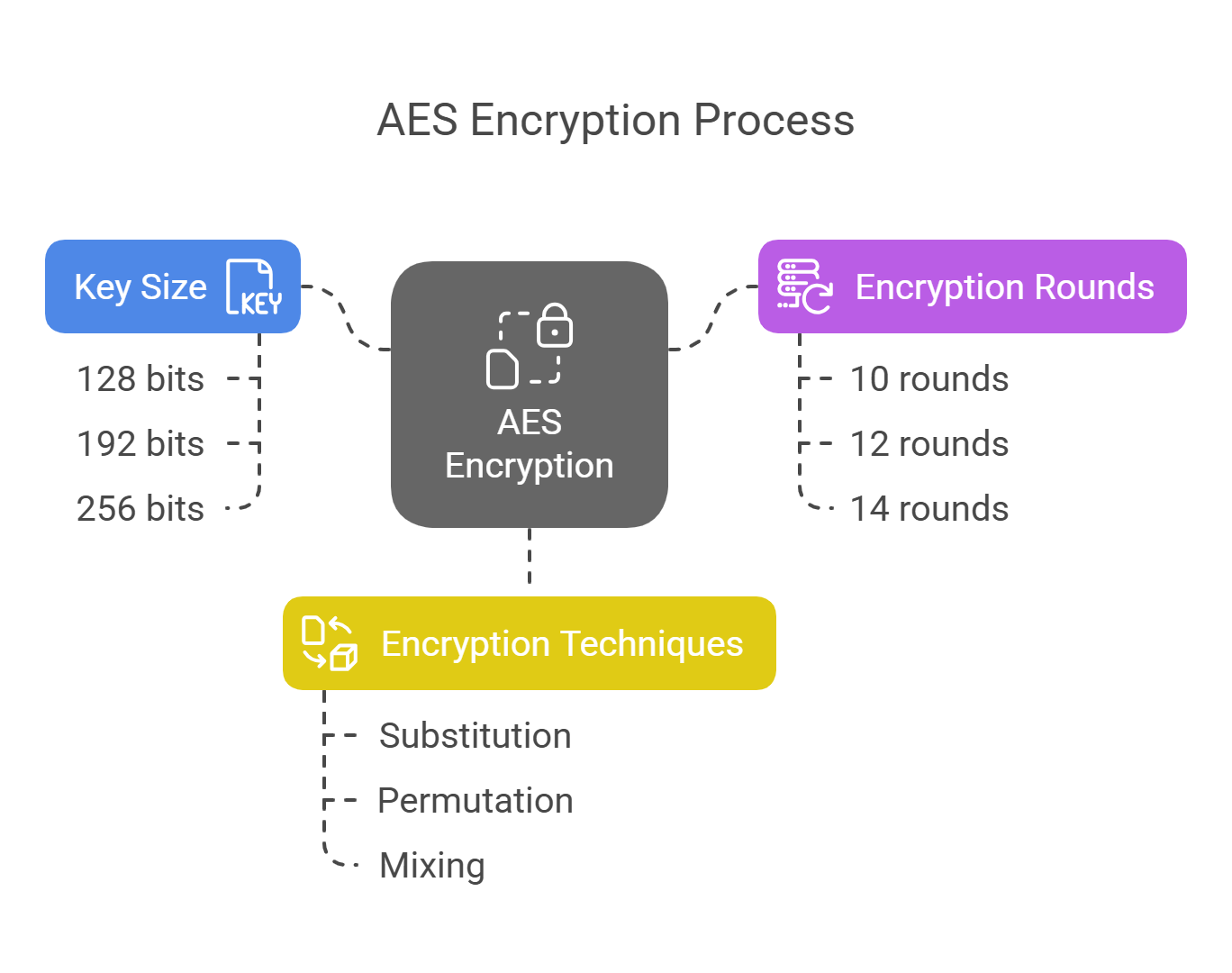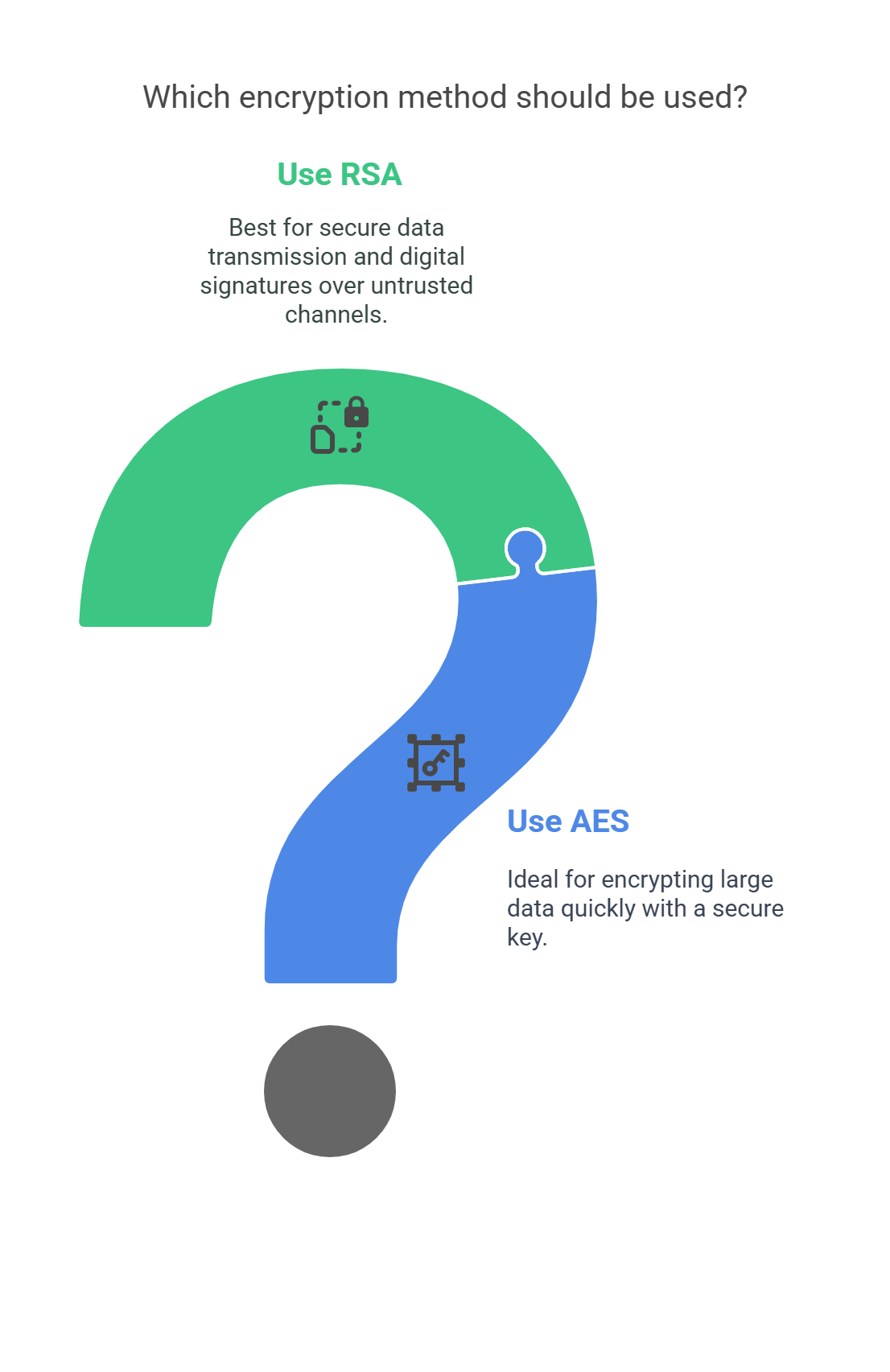Encryption is important for keeping your digital life safe. Whether it’s protecting personal data, securing transactions, or ensuring private messages, encryption algorithms like AES (Advanced Encryption Standard) and RSA (Rivest-Shamir-Adleman) are essential in keeping your information safe from cyber threats. In this post, we’ll explain what these encryption standards are, how they work, and when you should use them to protect your digital data.
What Is Encryption?
Encryption is the process of turning regular data into a secret code. It ensures only the right people can read it. Encryption protects sensitive data, so even if someone intercepts it, they can’t access it. Whether you’re sending messages, making payments, or storing files, encryption keeps everything safe.
What Is AES Encryption?
AES (Advanced Encryption Standard) is a symmetric encryption method. This means the same key is used to both encrypt and decrypt the data. AES became the official encryption standard for the U.S. government in 2001 due to its speed and security. It protects everything from Wi-Fi networks to financial transactions.
How AES Works
AES encrypts data in blocks, usually 128 bits at a time. It processes these blocks in several rounds of encryption. Depending on the key size (128, 192, or 256 bits), AES performs 10, 12, or 14 rounds to scramble the data, making it unreadable to anyone without the decryption key.
-
Substitution: Data is replaced with values from a lookup table.
-
Permutation: Data is rearranged to mix things up.
-
Mixing: Data is combined to make it harder to predict.

Advantages of AES
-
Security: AES is one of the most trusted encryption algorithms, known for its resistance to attacks.
-
Speed: AES is fast, even on systems with less power.
-
Efficiency: AES can handle large amounts of data without slowing down the system.
-
Wide Use: AES is used in modern systems, from smartphones to cloud services.
What Is RSA Encryption?
RSA (Rivest-Shamir-Adleman) is an asymmetric encryption method. It uses two keys: a public key for encryption and a private key for decryption. RSA was introduced in 1977 and is widely used in security protocols like SSL/TLS to secure websites.
RSA’s security comes from the difficulty of factoring large prime numbers, making it nearly impossible for attackers to decrypt the data without the private key.
How RSA Works
RSA works in three steps:
-
Key Generation: Two large prime numbers are multiplied together to create the public and private keys.
-
Encryption: The public key encrypts the data. Anyone can use the public key, but only the private key holder can decrypt the message.
-
Decryption: The private key decrypts the message. Since the private key is secret, only the intended recipient can read it.

Advantages of RSA
-
Strong Security: RSA’s strength lies in the difficulty of factoring large prime numbers.
-
Digital Signatures: RSA supports digital signatures, ensuring the authenticity of data.
-
Flexibility: RSA is widely used for securing emails, web traffic, and other digital communications.
-
Asymmetric Encryption: RSA’s two-key system is ideal for secure communication over the Internet.
AES vs. RSA: Key Differences
AES and RSA serve different purposes in securing digital information. Here’s a simple comparison:
| Feature | AES (Symmetric) | RSA (Asymmetric) |
|---|---|---|
| Key Length | 128, 192, or 256 bits | 1024 to 4096 bits |
| Encryption Type | Symmetric (same key for both encryption and decryption) | Asymmetric (public and private keys) |
| Speed | Fast, especially for large data | Slower, especially for large data |
| Security | Highly secure when used correctly | Extremely secure, but slower |
| Use Case | Data encryption (files, communication) | Secure communication (emails, web traffic) |
When to Use AES vs. RSA
Use AES When:
-
You need to encrypt large amounts of data quickly (e.g., for file storage or secure communication).
-
Speed and performance are important.
-
You can keep the encryption key safe.
Use RSA When:
-
You need to send data securely over an open or untrusted channel (e.g., email or web).
-
You need digital signatures to authenticate data.
-
You need a secure way to exchange encryption keys over the internet.

How AES and RSA Enhance Security
AES and RSA are often used together. AES handles the bulk encryption of data, while RSA secures the exchange of encryption keys. This layered approach to security keeps data safe during transmission, storage, and use. Both algorithms are used in protocols like HTTPS for secure web browsing and VPNs for private internet connections.
Conclusion
AES and RSA are two of the most important encryption standards. AES is fast and efficient for encrypting large amounts of data, while RSA provides strong security for key exchanges and digital signatures. Understanding how these encryption methods work helps you protect your data and digital communications.
By using AES and RSA together, you can ensure your information remains safe and your privacy is protected in our connected world.
FAQ
1. What’s the difference between AES and RSA encryption?
AES is symmetric, using the same key for both encryption and decryption. RSA is asymmetric, using a public key for encryption and a private key for decryption.
2. Why is AES so widely used?
AES is fast, secure, and efficient, making it ideal for encrypting large amounts of data on various platforms.
3. Can RSA encryption be cracked?
RSA is highly secure due to the difficulty of factoring large prime numbers. Larger key sizes make RSA more secure.
4. Which encryption method is best for websites?
Both AES and RSA are used together. RSA is used for key exchanges, and AES encrypts the data once the connection is established.


